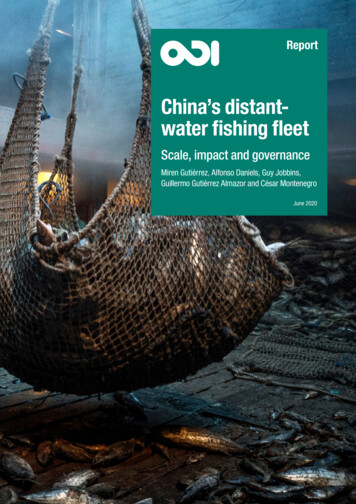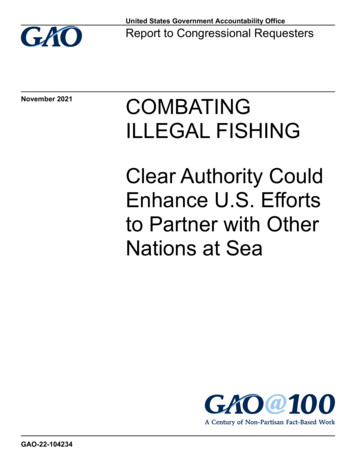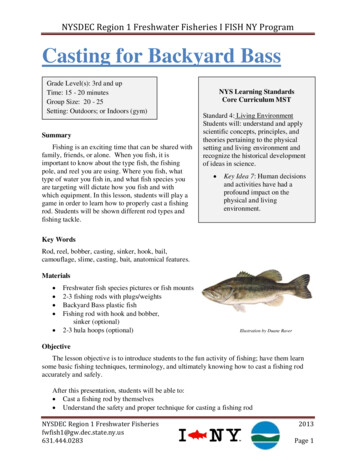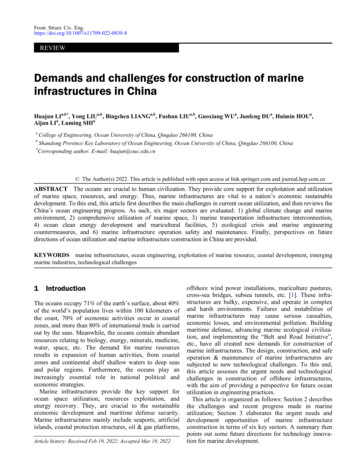
Transcription
ReportChina’s distantwater fishing fleetScale, impact and governanceMiren Gutiérrez, Alfonso Daniels, Guy Jobbins,Guillermo Gutiérrez Almazor and César MontenegroJune 2020
Readers are encouraged to reproduce material for their own publications, as long as they are not being sold commercially. ODI requests dueacknowledgement and a copy of the publication. For online use, we ask readers to link to the original resource on the ODI website. The viewspresented in this paper are those of the author(s) and do not necessarily represent the views of ODI or our partners.This work is licensed under CC BY-NC-ND 4.0.Cover photo: Workers offload frozen, net-caught tuna onto waiting trucks from a reefer cargo vessel owned by a Chinese company (Manila,Philippines). Adam Dean
AcknowledgementsThe authors are grateful to Roberto Mielgo for his generous assistance with data acquisition andanalysis, and the team at Vulcan’s Skylight for their support with data acquisition. All figures werecreated by Guillermo Gutiérrez Almazor. Deusto University, Bilbao, allowed us to use its facilitieswhen we needed to meet in person. Finally, we would like to thank John Pearce, from the MarineResources Assessment Group (MRAG), for generously contributing his time and expertise to reviewthis report. All errors remain those of the authors.3
ContentsAcknowledgements 3List of boxes, tables and figures 5Glossary 6Acronyms 7Executive summary 81Introduction 102Background 122.1China as a global fishing superpower 122.2Knowledge gaps and questions 123Data and methodology 144Findings and implications 154.11556China’s DWF fleet is 5–8 times larger than previous estimates 4.2 Trawlers are the most common DWF vessel, and most vessels are in the Northwest Pacific 164.3 Almost 1,000 Chinese DWF vessels are registered in other countries 214.4 The ownership and operational control of China’s DWF fleet is both complex and opaque 234.5 At least 183 vessels in China’s DWF fleet are suspected of involvement in IUU fishing 26Analysis: development implications 285.1 The scale, scope and impact of China’s DWF fleet and activities 285.2China’s DWF activities in a development context 305.3IUU fishing and its governance 31Conclusions and key policy recommendations 336.1Conclusions 336.2Key policy recommendations 34References 35Annex 1Methodology 41Annex 2Taxonomy of operations at sea 454
List of boxes, tables and figuresBoxesBox 1Identifying China’s distant-water fishing vessels 14Box 2The Chinese National Fisheries Corporation 25Box 3Poly Group Corp. 25Box 4China’s distant-water fishing in Ghana 29TablesTable 1Identifying China’s distant-water fishing fleet in the Krakken database 15Table 2 The composition of China’s distant-water fishing fleet 17Table 318Fishing operations observed in each global region during 2017 and 2018 Table 4 Distribution of owning and operating companies by fleet size 24Table 5 Largest six Chinese fleets of distant-water fishing vessels 24Table 6 Suspected illegal, unreported and unregulated fishing vessels per country flag 27Table A1Criteria for extractions from the Krakken database 42Figure 1Type of vessel for a sample of 4,798 Chinese distant-water fishing vessels 16Figure 2Intensity of fishing activity by China’s distant-water fishing fleet 19Figure 3Intensity of trawling activity by China’s distant-water fishing fleet 19Figure 4Intensity of long-lining activity by China’s distant-water fishing fleet 20Figure 5Intensity of squid-jigging activity by China’s distant-water fishing fleet 20Figure 6The 10 most common foreign-flag states for Chinese distant-water fishing vessels 21Figure 7Chinese distant-water fishing vessels flagged to African countries 22Figure 8Flags of convenience favoured by the Chinese DWF fleet 23FiguresFigure A1Trawling by the Chinese DWF fleet 46Figure A2Long-lining by the Chinese DWF fleet 46Figure A3Squid-jigging by the Chinese DWF fleet 47Figure A4Trap-setting by the Chinese DWF fleet 475
GlossaryAutomatic identification system (AIS)A ship-borne transponder sending signals on a vessel’s position, heading and speed.By-catchThe incidental or unintended capturing or killing of non-target species while fishing for another species. By-catch canbe fish, but also includes dolphins, whales, turtles and birds caught by fishing gear.Distant-water fishing (DWF)The commonly accepted international definition of DWF covers activities outside a nation’s 200-mile exclusiveeconomic zone (EEZ), whether on the high seas or in another nation’s EEZ.Exclusive economic zone (EEZ)A sea area up to 200 nautical miles from the coast, within which a state claims exclusive rights over marine resources.Flag of convenienceDescribing the permitted registration by a state of a vessel owned by foreign nationals. Commonly used pejoratively todenote flag states with low environmental, safety or labour standards.Geographic information system (GIS)A system that acquires, stores, collects, analyses, manages and visualises spatial or geographic data.Illegal, unreported and unregulated (IUU) fishingA range of offences covering fishing without permission or in violation of regulations of the flag state or host nation,misreporting or failure to report catches to relevant authorities where required to do so, fishing vessels without a flag ornational registration, or fishing on stocks without management measures in place.International Maritime Organization (IMO) numberA vessel’s unique number, usually maintained throughout the vessel’s length of service. Not required for fishing vessels,but common on industrial fishing vessels for reasons of security, taxes, certification and insurance.Maritime Mobile Service Identity (MMSI)A unique identification number used in radio communications. MMSI numbers are country specific, and in principle arechanged when a vessel is reflagged.Regional fisheries management organisation (RFMO)Multilateral organisations governing fishing interests for a specific area and/or species. While some RFMOs have apurely advisory role, most have management powers to set catch and fishing-effort limits, technical measures andcontrol obligations.Tonne1,000 kilograms.6
AcronymsAISautomatic identification systemCNFCChinese National Fisheries CorporationDG SANCOEuropean Commission’s Directorate General for Health and Consumer ProtectionDWFdistant-water fishingEEZexclusive economic zoneFAOFood and Agriculture OrganizationGISgeographic information systemIMOInternational Maritime OrganizationITWFInternational Transport Workers’ FederationIUUillegal, unreported and unregulatedMARAMinistry of Agriculture and Rural AffairsMMSIMaritime Mobile Service IdentityPGCPoly Group Corp.PSMAPort State Measures Agreement (Agreement on Port State Measures to Prevent, Deterand Eliminate IUU Fishing)RCMFRongcheng Marine Fishery Co. Ltd.RFMOregional fisheries management organisationSMEsmall- or medium-sized enterpriseUVIunique vessel identifiersVMSvessel monitoring systemWCPFCWestern and Central Pacific Fisheries Commission7
Executive summaryTrawlers are the most common DWF vessel,and most vessels are in the Northwest Pacific. Weidentified 1,821 individual Chinese DWF vesselsas trawlers. This is more than double the largestprevious estimate of the number of trawlers inChina’s DWF fleet. An analysis of 5,241 fishingmanoeuvres for 1,878 vessels during 2017and 2018 found that the most frequent area ofoperations was the Northwest Pacific. However,the most intense operations were squid fisheriesin the Southeast Pacific and Southwest Atlantic.Almost 1,000 Chinese DWF vessels areregistered in other countries. We identified 927vessels with Chinese owners, operators or otherChinese interests registered in other countries.518 of these are flagged to African nations, whereenforcement measures are generally limited,and where fishing rights are often restricted todomestically registered vessels. Just 148 vesselswere registered in nations commonly regardedas flags of convenience. This reflects the limitedincentives for adopting flags of convenience giventhe relatively lax regulation and enforcement ofChinese authorities.The ownership and operational control ofChina’s DWF fleet is both complex and opaque.Analysis of a subsample of 6,122 vessels foundthat just eight companies owned or operatedmore than 50 vessels. The majority of vessels areowned by small- or medium-sized enterprises(SMEs). Many of these may be subsidiariesof larger corporations for tax or regulatorypurposes. Labyrinthine company structuresand a lack of transparency are likely to hampermonitoring and enforcement efforts, and effortsto ensure those ultimately responsible formalpractice are held accountable.At least 183 vessels in China’s DWF fleet aresuspected of involvement in IUU fishing. Just 10companies own almost half of these vessels, andseveral are parastatal companies. This impliesHaving depleted fish stocks in domestic waters,the fleets of many industrialised countries arenow travelling further afield to meet the risingdemand for seafood. Much of this distant-waterfishing (DWF) takes place in the territorialwaters of low-income countries. As well ascompeting against the interests of local people,DWF in low-income countries is often associatedwith unsustainable levels of extraction, andwith illegal, unreported and unregulated (IUU)fishing activities.China’s DWF fleet is the largest in the world,and so is thought to have significant effects onthe environment and socioeconomic impactsin developing countries. Although China’sDWF fleet is known to be large, there is littleinformation available about its actual size andthe scale of its operations. For instance, recentassessments have produced estimates rangingbetween 1,600 and 3,400 vessels. In addition, itis unclear whether the Government of China hasa comprehensive overview of China’s DWF fleet;vessel ownership is highly fragmented amongmany small companies and the fleet includesvessels registered in other jurisdictions.With information from the Krakken database (FishSpektrum, 2018) and automaticidentification system (AIS) data for 2017 and2018, we investigated the size and operationsof China’s DWF fleet using big data analytictechniques, ensemble algorithms and geographicinformation systems (GISs).Key findingsChina’s DWF fleet is 5–8 times larger thanprevious estimates. We identified a total of16,966 Chinese DWF vessels. These include12,490 vessels observed outside internationallyrecognised Chinese waters between 2017and 2018.8
that Chinese authorities have the opportunity totarget their enforcement efforts efficiently andlead by example when it comes to enforcing andprosecuting IUU activities.Steps would include:Conclusions and recommendations Chinese DWF is not solely responsible for theglobal fisheries crisis: other countries are alsoresponsible for overfishing. The internationalcommunity has also failed to ensure oversightof international fishing operations, such asestablishing a global, centralised database of IUUvessels, and many governments in low-incomecountries are either unwilling or unable tomonitor their waters.However, the sheer size and global presence ofits DWF fleet, as revealed in this report, meansChina is the most significant actor. This makesthe low levels of transparency and control overthe operations of its DWF fleet of particularconcern. Improving the governance of this fleet iscentral to efforts to combat overfishing and IUUfishing, and to prevent the degradation of globalfish stocks.Our findings suggest that China faces agreater challenge than previously realised inmeeting its goal to reduce its DWF fleet to3,000 vessels. Our findings also concur withthose of other researchers who have identifiedsignificant gaps in China’s capacity for governingits DWF fleet. However, China can take steps todemonstrate global leadership on the governanceof DWF, sustainability of global fisheries andcombatting IUU. improving the registration and transparencyof DWF vessels, as well as owning andoperating companies;adopting higher standards such as ratificationof the Port State Measures Agreement(PSMA), as a flag state;stricter regulation and enforcement ofDWF operations; andstrengthening bilateral cooperation with stateswhere Chinese DWF vessels fish.Our findings also highlight the need formore effective regional and global action.International bodies and agencies can upgradecapacity for monitoring, information sharingand enforcement, take proactive measures todisrupt IUU stocks from entering internationalsupply chains, and support governance capacityin coastal developing states. Coastal developingstates that ratify international agreementsincrease transparency over international fishingagreements, and upgrade enforcement measureswill be better able to combat resource theftand corruption.These findings contribute to global work onthe scale, impacts and governance of China’sDWF fleet. More work is needed to explorethe ecological, social and economic impacts ofChina’s DWF fleet in developing countries, andto investigate the behaviour of transnationalcompanies engaged in DWF, particularly thoseregistered in flag-of-convenience states andtax havens.9
1IntroductionGlobal fishing effort has expanded rapidly sincethe 1950s, fuelled by technological advances,large public subsidies and increasing demand forfish protein (Tickler et al., 2018). This expansionhas severely and negatively affected global fishstocks; 90% of commercially exploited marinefish stocks are now either overfished or fished totheir maximum sustainable limits (FAO, 2016a).Fishing vessels now travel further in search ofdeclining catches. The average distance travelledhas doubled since the 1950s, with catches fallingfrom 25 kg per kilometre travelled to 7 kg perkilometre over the same period (Tickler et al.,2018). As fishing fleets have exhausted fish stocksin the waters of advanced economies, they arehunting further afield, particularly in the watersof low-income countries (Pauly, 2008). A recentanalysis found that in the exclusive economiczones (EEZs) of low-income countries, 84%of industrialised fishing effort came from othercountries and 78% came from vessels flaggedto higher- and upper-middle-income nations(McCauley et al., 2018)Distant-water fishing (DWF) often competeswith the interests of people in low-incomenations (Toppe et al., 2017). Economicallyweak countries in need of foreign currency, andwithout their own industrial fleets or scientificadvice on sustainable catch limits, often negotiatedisadvantageous fisheries agreements (Belhabibet al., 2014). Fragile governance and weakenforcement mean that low-income countriesare also most at risk from widespread problemsof illegal, unreported and unregulated (IUU)activities that accompany DWF fleets (Agnewet al., 2009; Daniels et al., 2016). For example,20% of the global IUU catch is estimated tocome from just six contiguous West Africancountries (Mauritania, Senegal, The Gambia,1Guinea-Bissau, Guinea and Sierra Leone).The opportunity cost of IUU activities to theeconomies of these six countries has beenestimated at 2.3 billion a year and 300,000jobs (Daniels et al., 2016; Belhabib, 2017).As such, DWF poses risks to the sustainable useof marine resources in low-income countries,and to the income, employment and foodsecurity of people dependent on these resources(Toppe et al., 2017).This report examines the size, composition andoperations of the Chinese fleet capable of DWF.1We focus on China as it is the dominant forcein the global fishing industry, with the largestdomestic and DWF fleets; China is also theworld’s largest producer of fish products (Paulyet al., 2014; Mallory, 2012; 2013).Despite the significance of China’s fishingindustry, assessment of its size and operationsis hampered by a lack of transparency and bythe limited availability of information in English(Mallory, 2013). Even estimates of the size ofChina’s DWF fleet vary considerably: from under2,000 vessels (Mallory, 2013) to around 3,400vessels (Pauly et al., 2014). Information on thegeographic location, types of fishing and catchesof the Chinese DWF fleet is also limited.The gaps in data on China’s DWF fleet areconcerning. They constrain understanding andmitigation of the ecological and socioeconomicimpacts of the fleet’s activities in specificterritories and undermine effective global andmultilateral governance.This report sets out to address some of theseknowledge gaps about the size and operations ofChina’s DWF fleet. We hope that our findings willbe of interest to research and policy communitiesaiming to improve the governance, monitoring,surveillance and sustainability of global fisheries.When referring to China, we mean the People’s Republic of China, excluding Chinese Taipei/Taiwan and the SpecialAdministrative Regions of Hong Kong and Macau.10
We set out to answer four key questions:Chapter 2 gives more information on China’srole and on previous studies. Chapter 3summarises our methodology, followed byChapter 4, which presents our five main findings.After a brief analysis of the developmentimplications of our findings (Chapter 5),we present our conclusions and key policyrecommendations in Chapter 6.1. How big is the Chinese DWF fleet?2. Where and how is it operating?3. Where are these vessels registered, and who isoperating them?4. What are the implications of the DWF fleet’sactivities for sustainable development?11
2Background2.1 China as a global fishingsuperpowervessels in the waters of other nations are rarelypublicly available (Pauly et al., 2014).Conservation organisation Oceana hasdescribed the lack of transparency in theactivities of China’s DWF vessels:China is a fisheries superpower. It has the largestfishing fleet and the largest DWF fleet in the world.In 2016, China captured 15.2 million tonnesof fish – around 20% of the global total – andconsumed 38% of total global fish production.China’s DWF caught two million tonnes, althoughChina provided details of species and fishingarea for only those catches marketed in China,representing 24% of the DWF catch (FAO,2018a). In the same year, China exported fish andfish products worth 20.1 billion – around 14%of the total global trade (FAO, 2018a).A relative latecomer to DWF, China beganoverseas fishing in 1985 when 13 vessels of theChina National Fishing Corporation set sailfor West Africa (Mallory, 2013). Since then,the number of Chinese DWF vessels has grownrapidly. As with other DWF fleets, this growth isdriven by increasing demand for fish outstrippinglocal supply. By 2012, 30% of fisheries in Chinahad collapsed, and 20% were considered overexploited (European Parliament, 2012).Like those of other countries, China’s pushto expand its DWF fleet has been fuelled bytax exemptions and subsidies for fuel and shipconstruction (Mallory, 2013; Kang, 2016). Fuelsubsidies have been a particularly importantcomponent of this boom, given the long tripsfrom ports in China to distant fishing waters(Kang, 2016).2.2(They) operate largely without accessagreements or under access agreementsthat are secret, thus we don’t evenknow if their catch is legal or not There are good reasons to think thatChina’s distant water fleets, legally ornot, catch well above the surplus in thecountries where they operate. Chineseauthorities are not publishing catchstatistics or evaluations of the stocksexploited by their fleets. (Oceana, 2013)Another key constraint is the limited availabilityof information in English (Mallory, 2013).In this section we summarise what is alreadyknown about Chinese DWFs and provide anoverview of key knowledge gaps.2.2.1 Fleet sizeThe size of China’s DWF fleet has been reportedas: 1,899 and 1,989 vessels in 2010 and 2011(Mallory, 2013); approximately 1,600 vesselswith over 30,000 crew in 2013 (EuropeanCommission, 2016); and around 3,432 vessels(Pauly et al., 2014) or 2,460 vessels (Greenpeace,2016a) in 2014. In comparison, the EuropeanUnion’s DWF fleet was 289 vessels in 2014, andthe United States had 225 large DWF vessels in2015 (Kang, 2016). Estimates of China’s DWFfleet generally focus on Chinese flagged vessels,and there is limited data available on the numberof Chinese-owned or joint venture vessels flaggedin other countries.The Chinese government does appear torecognise concerns about the size of its DWFfleet. At the 2017 World Trade OrganizationKnowledge gaps and questionsAs mentioned in the introduction, understandingof the size and operations of China’s DWF fleet isconstrained by a range of issues. One is a lack oftransparency. For example, developing bottomup estimates of China’s DWF activities is difficult,as bilateral fishing agreements governing Chinese12
summit in Buenos Aires, the Chinese governmentannounced plans to restrict the size of itsDWF fleet to 3,000 vessels by 2020, and tolimit catches to 2.3 million tonnes per year(Chun, 2018). This cutback is part of China’sThirteenth Five-Year Plan for Economic andSocial Development (2016–2020), which alsospecifies reductions in diesel fuel subsidies andthe elimination of IUU fishing (FAO, 2018a).Another question is the extent to which thegovernment of China has a comprehensiveoverview of the DWF fleet. Some 70% of thefleet is now in private ownership, with themajority of vessels owned by a proliferation ofsmall- or medium-sized enterprises (SMEs) ratherthan large, state-owned firms (Mallory, 2013).Fragmented ownership, joint venture operationsand reflagging of vessels seem likely to challengethe state’s ability to monitor the position andactivities of all vessels in China’s extensive fleet.2.2.22012). Another report from 2010 refers to 202trawling vessels in West Africa (Supportingand Strengthening Distant-water FisheriesTask Force, 2011, in Mallory, 2012). Mallory(2012) also refers to Chinese vessels operatingthroughout the Pacific and Southwest Atlantic,without giving figures.Taking a bottom-up approach, based onChinese vessels reported in different territories,including in various bilateral fisheriesagreements, Pauly and colleagues calculatedthat China operated 2,745 DWF vessels in Asia,mainly in the waters of Japan and South Korea,and 393 vessels in West and East Africa, withsmaller numbers of vessels operating in Oceania,Central and South America, and Antarctica(Pauly et al., 2014). While Mallory’s and Paulyet al.’s figures for vessels operational in Africaare strikingly similar (394 vs 393), their figuresfor DWF vessels in Asia are wildly different(732 vs 2,745).Geographical presence2.2.3 Vessel types and target speciesInformation on the geographical presence ofChina’s DWF is also limited. Mallory (2013)developed a limited picture by compilinginformation from various official Chinesepublic and industry sources. In this picture,in 2010, 732 Chinese vessels operated in thewaters of eight Asian countries (mostly NorthKorea, Indonesia and Myanmar) and 394Chinese vessels operated in 11 African countries,with larger fleets in Mauritania, Guinea andMorocco (Bureau of Fisheries, 2011, in Mallory,Information about the fishing gear and targetspecies of China’s DWF fleet is similarlyinconclusive. For example, various sources agreethat trawlers are the most common type of vessel,but figures range from 40% (Pauly et al., 2014;Agriculture Bureau of Fisheries, 2011, in Mallory,2013) to 60% (Lam et al., 2011, in Pauly et al.,2014). Estimates and reports for other types ofgear are similarly inconsistent, not helped by thedifferent systems used for classifying vessels.13
3Data and methodologyThe methodology underlying this studycombines the use of big data analytic techniques,ensemble algorithms and geographic informationsystems (GISs).We extracted data from the FishSpektrumKrakken database (FishSpektrum, 2018) on allpossible DWF vessels with connections to China(Box 1). Annex 1 describes the methodology inmore detail. We developed our own database todefine and categorise Chinese vessels capable ofDWF, and compared our data with findings inother expert literature.We also used GIS software to visualiseautomatic identification system (AIS) data andidentify fishing manoeuvres according to theirlocation and movement patterns (Annex 2).Based on expert knowledge, these fishingmanoeuvres were labelled to train algorithmsto detect patterns in the location data. Weused an ensemble of learning algorithms toidentify where and how vessels operate whenfishing. Finally, we combined all the analysis withother sources on IUU fishing.Descriptive and dynamic data limitationsare the leading methodological constraint onour findings. The Krakken dataset containsgaps, including missing information on regionalfisheries management organisation (RFMO)registration, vessel type, International MaritimeOrganization (IMO) and ownership. This impliesthat our figure for the size of China’s DWF fleetmay be an underestimate. Another possible causefor an underestimate are gaps in the dynamicdata, with AIS data unavailable for 2,462(14.5%) of Chinese-registered vessels.Box 1 Identifying China’s distant-waterfishing vesselsThe DWF vessels of one country are thoseoperating within the EEZs of anothercountry, or further offshore on the highseas (Oceana, 2013). However, identifyingwhich vessels are operating where isnot simple.To identify Chinese DWF vessels, welooked at records of vessels: registered withspecific Chinese public agencies responsiblefor regulating DWF; registered withforeign governments; or inspected outsideChinese waters. We also looked at vessels’unique Maritime Mobile Service Identity(MMSI) transponders being detected asactive outside Chinese waters on a sampleof dates during 2018. The methodology isdescribed in more detail in Annex 1.14
4 Findings andimplicationsOur analysis of the data has identified five keyfindings:4.1 China’s DWF fleet is 5–8 timeslarger than previous estimates1. China’s DWF fleet is 5–8 times larger thanprevious estimates.2. Trawlers are the most common DWF vessel,and most vessels are in the Northwest Pacific.3. Almost 1,000 Chinese DWF vessels areregistered in other countries.4. The ownership and operational controlof China’s DWF fleet is both complex andopaque.5. At least 183 vessels in China’s DWF fleet aresuspected of involvement in IUU fishing.We identified 16,966 vessels in the Krakken database as members of China’s DWF fleet(Table 1). This is 5–8 times larger than theestimates of 1,989 vessels provided by Mallory(2013), 3,432 vessels by Pauly et al. (2014), or2,460 vessels by Greenpeace (2016b).The largest subgroup we identified wasof 12,490 vessels without IMO or RFMOregistrations but with active AIS signalsoutside Chinese waters at some point between1 January 2017 and 31 December 2018.Table 1Identifying China’s distant-water fishing fleet in the Krakken ed IMO or RFMO number ––––Registered RFMO number– –––––––Registered with Chinese DWFAssociation––––––––– AIS signal outside Chinese EEZ in2017 or 2018–– –––––––Currently flagged to China Not currently flagged to China––– ––––Previously flagged to China–––– –––––Never flagged to China–––––– –––Inspected by Chinese authoritiesoutside Chinese waters in 2018––––––– ––Exported or impounded by Customs–––––––– –Built in China––– ––––Related to Chinese interests––––– –––2,07657512,490431928631837982437Number of vesselsSource: elaborated from FishSpektrum (2018).15
We assume that this remote observation of avessel’s presence overseas grants high confidencethat it is engaged in DWF operations. If weconsider only this group – discounting all otherresults – the figure of 12,490 vessels is still 3.5times larger than the estimate of Pauly et al. (2014).We also identified 3,541 vessels with eithera registered intention to fish overseas or incontact with Chinese enforcement agencies incircumstances that strongly imply engagementin DWF fishing. These included Chinese-flaggedvessels: with IMO numbers (Extraction 1),registered with RFMOs (Extraction 2), registeredwith the Chinese DWF association (Extraction6.4), inspected by Chinese authorities outsideChinese waters during 2018 (Extraction 6.2),or registered as exported or seized by Chinesecustoms agents (Extraction 6.3).Additionally, we identified 927 vessels flagged byother countries that have associations with Chinathat we assume are significant. These includevessels built in or previously flagged to China, orwith a Chinese interest, meaning that they havea current or previous Chinese name, operatoror owner. These vessels may be flagged to othernations but were operated by Chinese businessesor their subsidiaries, contributing to China’s supplychains and international fishing effort.Our identification of vessels as members of theDWF fleet does not imply that all are operatingcurrently, simultaneously or consistently inforeign or international waters. This is partlydue to gaps in the available data, and partly dueto the criteria used to identify the DWF fleet.Krakken ’s records are not updated in real timeand do not reflect the current status of somevessels. For example, Krakken may record avessel as being operational during 2017, but notrecord that it was decommissioned in early 2018.There are 58 Chinese vessels whose last recordin Krakken was ‘active and operational’ before1989; these vessels may no longer be operational.4.2 Trawlers are the most commonDWF vessel, and most vessels are inthe Northwest Pacific4.2.1 Numbers of DWF trawlersKrakken contains details on the type of vesselfor 4,798 of the DWF vessels we identified. Ofthese, 1,821 (38%) were trawlers, 993 (20.7%)were long-liners, 625 (13%) were squid-jiggers,358 (7.5%) were seiners, and 334 (7%) were gillnetters. A further 667 vessels (13.9%) were ofother types or served in support roles (Figure 1).Figure 1 Type of vessel for a sample of 4,798 Chinese distant-water fishing vesselsOthers (174) 3.63%Multipurpose (136) 2.83%Reefer (150) 3.13%Carrier (207) 4.31%Gill-netter (3
5 List of boxes, tables and figures Boxes Box 1 Identifying China's distant-water fishing vessels 14 Box 2 The Chinese National Fisheries Corporation 25 Box 3 Poly Group Corp. 25 Box 4 China's distant-water fishing in Ghana 29 Tables Table 1 Identifying China's distant-water fishing fleet in the Krakken database 15 Table 2 The composition of China's distant-water fishing fleet 17









